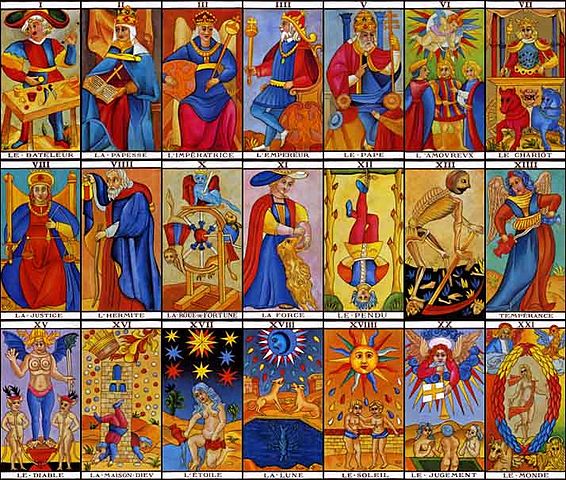Marseilles Tarot: Medieval symbology about minor colours.
Due to the reference made in this work for the Middle Ages where Yellow, Blue, Red, White and Black were considered to be "true colours" and having in mind that Nicolas Conver's Tarot comes from the 18th century and the "minor colours" term is very questionable, this article is established as a second part of Medieval symbology about the colours in the Marseille's Tarot. Likewise we will find here some colours which do not match with those that appear in the mentioned Tarot but in early or late versions which had an special attention.
Green: Green is a natural colour with limited uses. Out of nature, it has a negative or neutral value. In Middle Ages, the characters in green usually tend to mean betrayals and rashness, greed and lack of moderation. However, they give youth and vitality to the environment. It is a very earthly colour but in the middle of yellow and blue it became a colour which attracts fortune as an meddler of divine forces so it is a symbol for balance.
It has a marginally symbolic use in the cards, it appears on grounds and plants and on the characters' clothes, it is used for the chromatic pattern needed to balance the image. If we follow medieval ideas, yellow and green together would announce chaos but green with blue would be a positive thing. Without blue, green would take its place and symbolism. In objects it would represent the natural flow.
Brown: A colour of immediate natural value. It is related to earth. It has not a real importance in the medieval symbolism but it is common to be represented as a colour of balance and growth -associating it with wood and trees-. However it is also related to the modest religious habits so it was seen as a humble but worthy colour.
Flesh tone: Only used for skin colour, it shows human or animal figures, it is related with living beings and therefore is important not so much for the images -as it happens on knaves, knights and kings in Minor Arcana- but for the idea of caring about the consultant or the person who carries out the process.
Orange: Related with yellow in its positive aspect. It is a happy, cheerful, positive colour and full of life. It is a substitute for gold's bright except when it represents human flesh or ground. In these cases it must be related to "flesh tone" and "brown".
Purple: Pastoreau (2006) defines it as an intermediate colour or half colour. It has a huge range so it had different approaches. In one hand it was the colour for kings and emperors as red was, but at the same time it was a spiritual colour due to the cloth given to Jesus. It was also related to esotericism.
Gold: It was not included on yellow because of the differences. In the old Tarot which had more gold since modern impressions avoid it, gold represented an exclusive value and physical, moral and spiritual wealth. Of course when gold appeared on frames and filigree it had no meaning. However, gold in a character represented nobility, used in characters with power or spiritually wealthy, as well as in objects made of gold. When a character lacked of this colour it represents earthly events.
Pink: Pink is a colour which had properties from red, but it was also stripped from all of its virtues according to its saturation. Sometimes it was a minor colour, sometimes it was mild, fertile, typical for childhood and females. It must have a calm interpretation although this colour does not usually appear.
Grey and Silver: This two colour must be gathered because they share a lot of symbolism. Grey is austere, between white and black so it is balanced and serious. It represents mourning, death, ashes and spiritual humbleness as well as wisdom and fulfilment.
Silver's value was always below gold's. Because of the betrayal to Jesus portrayed by Judas in exchange of thirty silver coins, silver had a negative or inferior value. However, since gold was used for decoration, this made it very common, so silver would acquire positive and humble meanings from grey along with fortune. Nevertheless neither of both receives a extensive treatment out of their own elements, buildings, stones or weapons. .
White: The argument whether white is lack of colour or not has not a place in this article because in the Middle Ages white was considered as a colour at the same level as black, blue, red and yellow. It is the last colour here for a simple reason: in Tarot, it is the background colour so it has no meaning. In clothes, it represents purity, knowledge and light; in hair it means wisdom but its meaning has not more relevance due to the limited use.
Pietro Viktor Carracedo Ahumada - pietrocarracedo@gmail.com
Translated by: Rachel Black - raquel_carrasco91@hotmail.com
Bibliography:
-Gage, J., Color and culture: practice and meaning from Antiquity to Abstraction. Univ. of California, 1999-Jung. C.G., El hombre y sus símbolos, Ed. Planeta, 1995
-Nicholls, S. Jung y el Tarot: un viaje arquetípico. Kairós, 1989
-Pastoreau, M., Breve historia de los colores. Paidós Ibérica, Barcelona, 2006
-Portal, F., El simbolismo de los colores: en la antigüedad, en la edad media y en los tiempos modernos. J. de Olañeta (ed.) 1996
Related articles:


